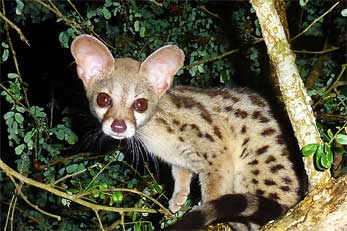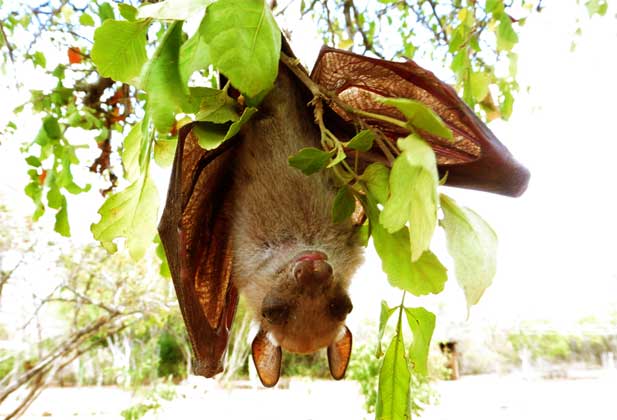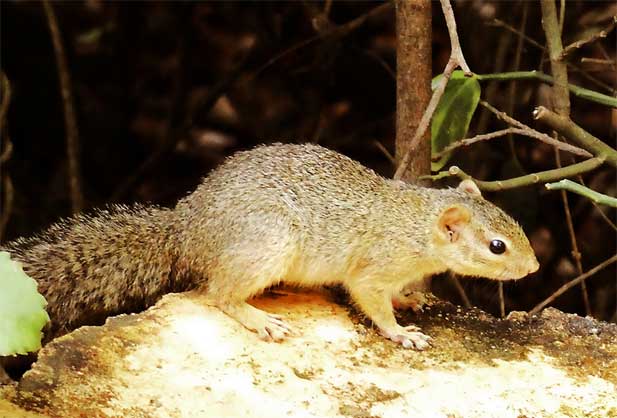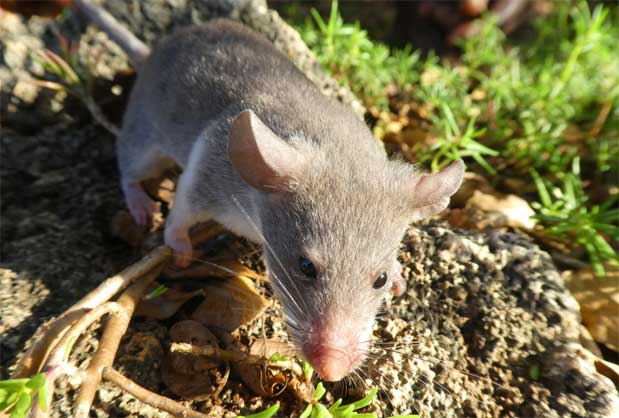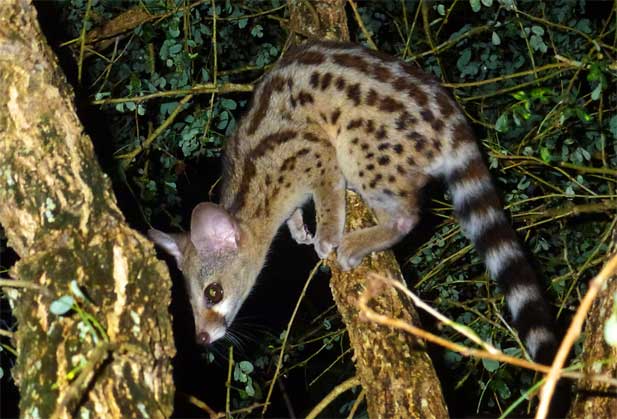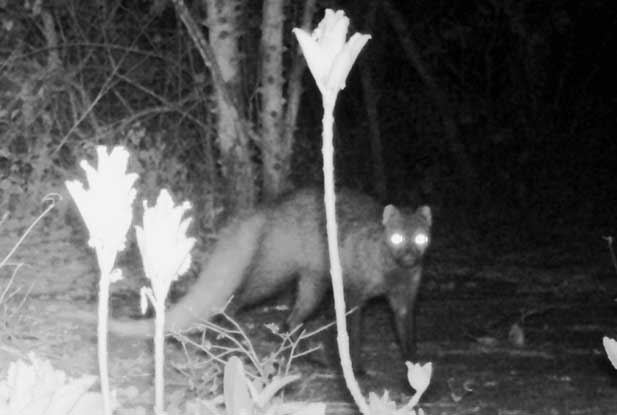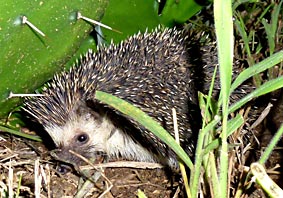|
Mammals Also some wild animals live on our farm and in the surrounding area. Although there has long been no more lions and elephants here, but at least there are some species that have found their niche here to survive in the woods and in the bush. Some of them we see now and again in the garden. We look forward and of course we took pictures. We don't have
the "Big Five" here,
You have to be lucky to see all these animals. |
||||||||||||||||||||||||||||||||||||||
Overview of mammals
|
||||||||||||||||||||||||||||||||||||||
|
||||
 |
 |
|||
| Whitetail mangoes prefer a habitat from semi-desert to savannah bushland. They like dense undergrowth as it is usually found at forest edges. They can weigh over 5 kg and reach a body length of more than 70 cm. Their tail length is almost 50 cm. He is therefore the largest representative of the mangoose family with his very long legs. The narrow long head runs pointedly to the nose. The round ears sit on the side of the head. These animals are yellowish-brownish but their black guard hairs gives them a gray elegant appearance. The back and front legs are black to the lower half. The bushy tail is yellowishh-brown then white and tapers to a point. Females have four teats. Mongooses mainly eat insects, but also snakes and other vertebrates, as well as eggs and fruits. They are known for their predatory behavior in poultry houses. They are nocturnal, during the day they sleep in free earth holes under roots, in termites or porcupines cavities. |
||||
|
||||
 |
||||
 |
||||
 |
||||
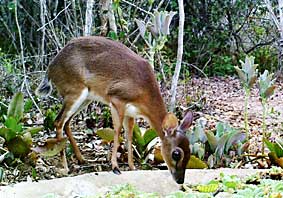 |
 |
 |
||
 |
 |
 |
||
 |
 |
 |
||
 |
 |
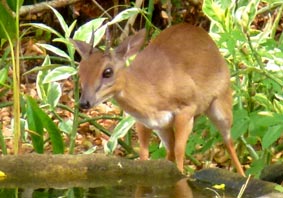 |
||
 |
 |
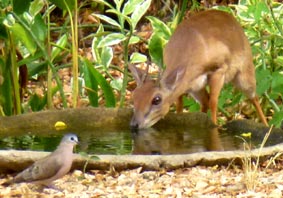 |
||
 |
 |
 |
||
 |
 |
 |
||
 |
 |
 |
||
 |
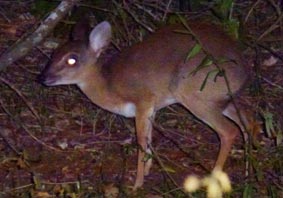 |
 |
||
|
On a night walk we saw this suni baby hiding in the bush. The mother
was looking for food. |
||||
|
Sunis are crepuscular and nocturnal animals. They live in the surrounding forest and scrubland and are very shy. No wonder, because they are hunted by locals with bow and arrow and with dogs or trapped in traps. But here at the farm the up to 6 kg of animals are relatively safe and often visit us at the water holes, especially during dry season. With a shoulder height of about 45 centimeters, Sunis belong to the smallest antelopes in the world. Only the males have horns, which can be up to 12.5 cm long. Sunis live in small herds; consist of a male with up to four females and calves. They communicate by smell but they can also bark and whistle, which we can often hear clearly. Their main food is leaves, fruits, flower buds, mushrooms, shoots and leaves. Since they absorb liquid over their food, they drink little. During the dry season they come almost daily from the nearby bush, through the garden, drink and disappear quickly. They are always ready to flee at the slightest disturbance. With great luck, we see Sunis on our nightly excursions through our bush. | ||||
|
||||
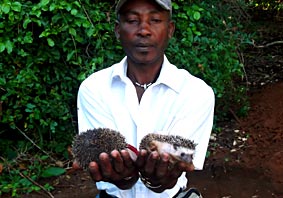 |
 |
 |
||
|
|
|
|
||
This up to 21 centimeters little hedgehogs live solitary. They prefer bush and grassland. Their diet consists mainly on insects, which they capture at night. When this little comrades did not found a place to sleep we often see them still in the early morning hours. They look for sleeping place under dry leaves, bushes or in termite mounds. Curled up in a spiky ball, the animals sleep at day until dusk. The mostly 300 to 400-gram insectivores often are victims of huge eagles and owls. | ||||
|
||||
|
|
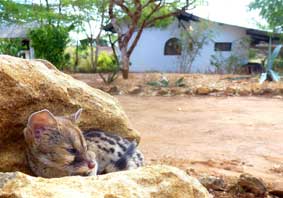 |
||
 |
 |
 |
||
 |
 |
|||
 |
||||
|
Genets belong to the family of civets and with luck they can also be seen here in our garden. These omnivores can weigh 1-3 kg and hunt their prey usually on the ground. Since they are also excellent climbers they supplement their diet with eggs and young birds. During the day they sleep in hollow tree trunks or crevices. They live as loners and roam at night through their territory, which may be up to 8 square kilometers. After about two and a half months gestation period 2-3 young are born and nursed for 1 month. | ||||
|
||||
 |
 |
 |
||
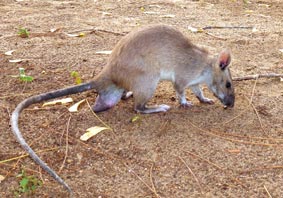 |
 |
 |
||
| Gambia giant pouched rat lives throughout Africa, including here in the bush of our farm. They gather their food like hamsters in cheek pouches and carry it in their construction. With a body length of about 45 centimeters, the tail is as long, they are among the large rodents on earth. The males take up to 2.5 kilos, females are slightly lighter. The short coat is gray-brown on top and white on the underside. Giant
pouched rats preferred inhabit natural caves or termite mounds. You
can also lend a cave, which then consist of several chambers. The up
to 6 ports are well camouflaged and are usually located in the dense
undergrowth. After about 6 weeks, the female gives birth to usually 2 to 4 cubs which are born naked and blind. Giant pouched rats are around 7 years old. Due to the strong smell intelligent rodents are also bred and used for an approximately 8-month training to detect landmines. Preliminary tests have shown that they can test saliva samples for tuberculosis much faster than with a microscope. Giant pouched rats are bred for some time by the people and traded in local markets as food. | ||||
|
||||
 |
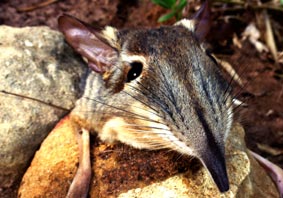 |
 |
||
The elephant shrews live in the savanna forests of East-Africa. Even in our forest it can be found as dawn active animal. The long movable nose is like a proboscis, which they are always looking for ants, termites, beetles and worms. The elephant shrew are true artists in the creation of escape routes. At the slightest suspicion of danger they flee quickly from their nest on this route network. After a gestation period of about 3 months the female gives birth to 3 offspring into the world, who are already quite well developed. After a few hours they are already getting around independently capable. |
||||
 |
 |
 |
||
 |
 |
 |
||
|
||||
 |
 |
 |
||
 |
 |
 |
||
 |
 |
 |
||
 |
 |
 |
||
| Weighing up to 300 g and 21 cm body length, the Senegal Galagos belong to the middle-sized of its kind. The bushy tail is also 30 cm long. They live in dry savannah areas and keep mainly in trees and bushes on. Because of their nocturnal screams reminiscent of toddlers, they are also called bush babies. As loners, they go in search of food, while they eat insects, sweet fruit, eggs, seeds and flowers, as well as tree saps. With their big eyes they are very well adapted to the dark. The strong hind legs give them enormous bounce. A grooming claw, as with all Strepsirrhini, located on the second toe. After a gestation period of about 4 months 1 or 2 young are born and nursed three and a half months. Bush babies sleep during the day with several animals cuddled in hollows or other hiding places, such as empty birds' nests. | ||||
| ||||

| 
| 
| ||

| 
| 
| ||
|
This leaf-nosed bat has a considerable span of 70
centimeters. A quite large specimen.
With a small tree branch we were able to put the pointed teeth freelywhich are in a strong bite. Have so far only twice seen such a big bat at us. Bats start after dusk for food intake. They fly fast and with jagged maneuvers through the air. They feed mainly on insects, but also eat fruits Under our roof lives a colony of a smaller and different species. But more about that later. | ||||
Back
to |
Home |




